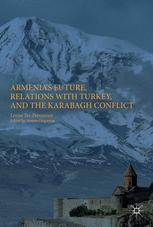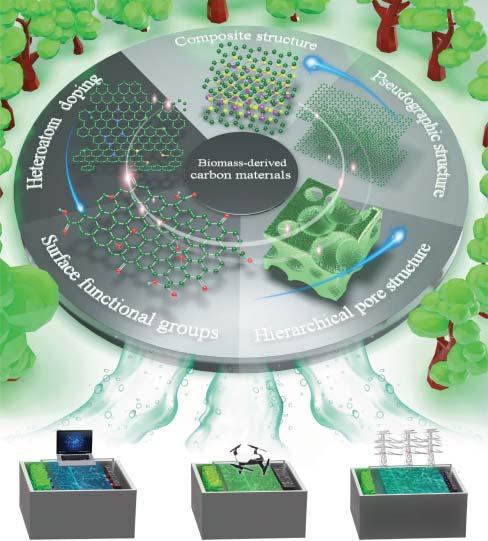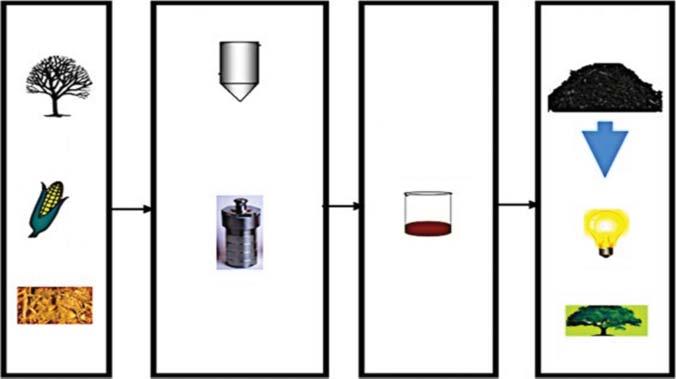Biomass-DerivedCarbonMaterials
ProductionandApplications
Editedby
AlagarsamyPandikumar,PerumalRameshkumar,and PitchaimaniVeerakumar
Editors
Dr.AlagarsamyPandikumar ElectroOrganicandMaterials ElectrochemisryDivision (CSIR)-CentralElectrochemical ResearchInstitute Karaikudi-630003,TamilNadu India
Dr.PerumalRameshkumar DepartmentofChemistry KalasalingamAcademyofResearchand Education,Krishnankoil-626126 TamilNadu India
Dr.PitchaimaniVeerakumar InstituteofAtomicandMolecular SciencesAcademiaSinica(IAMS) NationalTaiwanUniversity,10617 Taipei Taiwan
Cover:©From“RecentAdvanceson PorousCarbonMaterialsfor ElectrochemicalEnergyStorage”by LibinWangandXianluoHu,Chem. AsianJ.10.1002/asia.201800553, CopyrightWiley-VCHGmbH. Reproducedwithpermission.
Allbookspublishedby WILEY-VCH arecarefully produced.Nevertheless,authors,editors,and publisherdonotwarranttheinformation containedinthesebooks,includingthisbook, tobefreeoferrors.Readersareadvisedtokeep inmindthatstatements,data,illustrations, proceduraldetails,orotheritemsmay inadvertentlybeinaccurate.
LibraryofCongressCardNo.: appliedfor
BritishLibraryCataloguing-in-PublicationData Acataloguerecordforthisbookisavailable fromtheBritishLibrary.
Bibliographicinformationpublishedby theDeutscheNationalbibliothek TheDeutscheNationalbibliotheklists thispublicationintheDeutsche Nationalbibliografie;detailedbibliographic dataareavailableontheInternetat <http://dnb.d-nb.de>.
©2023WILEY-VCHGmbH,Boschstraße12, 69469Weinheim,Germany
Allrightsreserved(includingthoseof translationintootherlanguages).Nopartof thisbookmaybereproducedinanyform–by photoprinting,microfilm,oranyother means–nortransmittedortranslatedintoa machinelanguagewithoutwrittenpermission fromthepublishers.Registerednames, trademarks,etc.,usedinthisbook,evenwhen notspecificallymarkedassuch,arenottobe consideredunprotectedbylaw.
PrintISBN: 978-3-527-34926-5
ePDFISBN: 978-3-527-83289-7
ePubISBN: 978-3-527-83291-0
oBookISBN: 978-3-527-83290-3
Typesetting Straive,Chennai,India
Contents
Preface xi
Acknowledgments xiii
1IntroductiontoBiomass-DerivedCarbonMaterials 1 A.Sivakami,R.Sarankumar,S.Vinodha,andL.Vidhya
1.1Introduction 1
1.2BiomassResourcesandComposition 3
1.2.1Plant-BasedBiomass 4
1.2.2Fruit-BasedBiomass 5
1.2.3Microorganism-BasedBiomass 7
1.2.4Animal-BasedBiomass 7
1.3ConditionforPrecursorSelectionofBiomass-DerivedCarbon 8
1.4ProductionMethodsofBiomass-DerivedCarbon 8
1.4.1Carbonization 9
1.4.1.1HydrothermalCarbonization 9
1.4.1.2Pyrolysis 10
1.5Biomass-DerivedCarbons(B-d-CMs)ActivationMethods 11
1.5.1PhysicalActivation 11
1.5.2ChemicalActivation 13
1.5.3CombinationofPhysicalandChemicalActivation 14
1.5.4ModificationandStructuralControlofB-d-CMs 14
1.5.4.1SurfaceModificationandHeteroatomDopingofB-d-CMs 15
1.5.4.2B-d-CMsSurfaceLoadingofMetalOxidesorHydroxides 15
1.5.4.3SurfaceIncorporationwithDifferentNanostructures 17
1.6ProductionProcessDescription 17
1.7CostAnalysis 19
1.8Summary 19 References 20
2IntroductiontoBiowaste-DerivedMaterials 27 ThangaveluKokulnathan,BalasubramanianSriram,Sabarison Pandiyarajan,SubramanianRamanathan,andThangaveluSakthiPriya
2.1Introduction 27
2.2Synthesis 28
2.2.1ActivationMechanismofBW-ACbyPhysicalActivation 28
2.2.2ActivationMechanismofBW-ACsbyChemicalActivation 29
2.2.2.1InfluenceofAlkalineActivatingAgents 30
2.2.2.2InfluenceofAcidicActivatingAgents 31
2.2.2.3InfluenceofNeutralActivatingAgents 31
2.2.2.4InfluenceofSelf-ActivatingAgents 32
2.3Characterization 32
2.3.1ElectronMicroscopes 32
2.3.2HR-TEMAnalysis 34
2.3.3FTIRSpectroscopy 35
2.3.4RamanSpectroscopy 36
2.3.5XPSAnalysis 38
2.3.6XRDPatterns 39
2.3.7BETAnalysis 41
2.4Properties 43
2.4.1SurfaceDefectsinBW-AC 43
2.4.2CharacterizationsofCarbonDefects 46
2.4.3IntrinsicCarbonDefectsActivity 47
2.4.4HeteroatomDopingDefects(or)ExtrinsicCarbonDefectsActivity 48
2.4.5ElectronicBandStructureProperties 48
2.5Summary 50 References 50
3Biomass-derivedCarbon-basedMaterialsforMicrobicidal Applications 63 SelvamuthuPreethi,ArunachalamArulraj,RamalingaViswanathan Mangalaraja,VelayuthamRavichandran,andNatesanSubramanian
3.1Introduction 63
3.2BiomassMaterials 64
3.2.1CarbonandItsDerivatives 65
3.3Microbicidal 66
3.3.1MechanismofAction 67
3.3.2MicrobicidalResistance 68
3.3.3FactorsAffectingMicrobicidalResistance 68
3.4MicrobicidalPerformanceofBiomass-DerivedCarbonaceous Materials 69
3.4.1RoleofMaterialPhysicochemicalProperties 70
3.4.1.1StructuralDestruction 70
3.4.1.2OxidativeStress 73
3.4.1.3WrappingEffect 76
3.4.1.4PhotothermalEffect 77
3.4.1.5ExtractionofLipid 78
3.4.1.6MetabolicInhibitoryEffect 79
3.5BioengineeringProspectiveTowardCarbonaceousMaterials 79
5.5.1MetalIonSensing 117
5.5.1.1Mercury(Hg2+ )Sensor 118
5.5.1.2Iron(Fe3+ )Sensor 119
5.5.1.3Lead(Pb2+ )Sensor 120
5.5.1.4Copper(Cu2+ )Sensor 120
5.5.1.5MiscellaneousMetalIons 122
5.5.2AnionSensors 122
5.5.3MiscellaneousMolecules 123
5.6ConclusionandFuturePerspectives 123 References 124
6Biomass-DerivedMesoporousCarbonNanomaterialsforDrug DeliveryandImagingApplications 129 BalajiMaddiboyina,RamyaKrishnaNakkala,andGandhiSivaraman
6.1Introduction 129
6.2DrugDeliverySystemsBasedonMCNs 130
6.2.1Immediate-releaseDDS 130
6.2.2Sustained-releaseDDS 130
6.2.3Controlled/TargetedDDS 131
6.3PhotothermalTherapy 131
6.3.1SynergisticTherapy 135
6.3.2CellLabeling 135
6.3.3RemovalofToxicSubstances 139
6.3.4TransmembraneDelivery 139
6.3.5PhotoacousticImaging 139
6.3.6TherapeuticBiomoleculeDelivery 140
6.3.7Biosensing 140
6.3.8MagneticResonance(MR)Imaging 142
6.4ConclusionandFuturePerspectives 143 References 143
7MesoporousCarbonSynthesizedfromBiomassasAdsorbent forToxicChemicalRemoval 147 BabuCadiamMohan,SrinivasanVinjuVasudevan,RamkumarVanaraj, SundaravelBalachandran,andSelvamaniArumugam
7.1Introduction 147
7.2SynthesizedMethodsofMesoporousCarbonsfromBiowasteor Biomass 148
7.3ApplicationofMesoporousActivatedCarbons 149
7.3.1RemovalofDyes 149
7.3.1.1GWACasanAdsorbentforMethyleneBlueandMetanilYellow 150
7.3.1.2RiceHusk(RH)-DerivedMesoporousActivatedCarbon(AC)for MethyleneBlue(MB)DyeRemoval 151
7.3.1.3ActivatedCarbonfromRattanWasteforMethyleneBlue(MB) Removal 152
8.4.1.2MetalOxides@Biomass-derivedCarbonNanocomposite Electrodes 186
8.4.1.3MetalSulfides@Biomass-derivedCarbonNanocomposite Electrodes 188
8.4.2Na-IonBatteries(SIBs) 189
8.4.2.1Biomass-derivedUndopedCarbonElectrodes 190
8.4.3Li-Sbatteries 195
8.4.3.1Biomass-derivedCarbonHosts 198
8.4.4Zn-AirBatteries 199
8.5Biomass-derivedHeteroatom-DopedCarbonElectrodesforRBs 201
8.5.1Single-Heteroatom-DopedCarbonElectrodes 202
8.5.2Dual-Heteroatom-DopedCarbonElectrodes 204
8.6SummaryandFutureProspectives 206 References 207
9RecentAdvancesinBio-derivedNanostructuredCarbon-based MaterialsforElectrochemicalSensorApplications 215 AkshatMathur,JayashankarDas,andSushmaDave
9.1Introduction 215
9.2ConclusionandFuturePerspectives 224 References 225
10PorousCarbonDerivedFromBiomassforFuelCells 229
A.Sivakami,AristatilGanesan,P.Sakthivel,KishoreSridharan, SabarinathanVenkatachalam,andSudhagarPitchaimuthu
10.1Introduction 229
10.2FuelCells–TheoryandFundamentals 233
10.3CatalystSupportMaterials 234
10.3.1AsaCatalyst 236
10.3.2SynthesisMethodsofPorousCarbonfromBiomass 236
10.4PorousCarbonSynthesisfromDifferentBiomass 237
10.4.1OxygenReductionReaction(ORR) 237
10.5SynthesisofBiomass-DerivedORRCatalystforFuelCell 238
10.6FutureOutlook 245
10.7Summary 245 References 246
11Biomass-DerivedCarbon-BasedMaterialsforSupercapacitor Applications 253
G.Murugadoss,M.Rajaboopathi,M.RajeshKumar,and A.M.KamalanKirubaharan
11.1Introduction 253
11.1.1Capacitor 253
11.1.2Battery 254
11.2Supercapacitor 255
x Contents
13RecentAdvancesofBiomass-DerivedPorousCarbonMaterials inCatalyticConversionofOrganicCompounds 293 N.MahendarReddy,D.Saritha,NaveenK.Dandu,Ch.G.Chandaluri,and GubbalaV.Ramesh
13.1Introduction 293
13.2SynthesisProcedures 295
13.2.1Carbonization 295
13.2.1.1HydrothermalCarbonization(HTC) 296
13.2.1.2Pyrolysis 297
13.2.2Activation 297
13.2.2.1PhysicalActivation 297
13.2.2.2ChemicalActivation 298
13.2.3PhysicochemicalActivation 299
13.2.4Microwave-basedsynthesis 299
13.2.5Functionalization/Doping/CompositesofACs 300
13.3Applications 302
13.3.1HeterogeneousCatalysis 302
13.4ConclusionandFutureChallenges 308 References 309
14SummaryonPropertiesofBio-DerivedCarbonMaterialsand theirRelationwithApplications 317
S.Vinodha,L.Vidhya,andT.Ramya
14.1RemovalofToxicChemicals 321
14.2ElectrodeMaterialsforBatteries 322
14.3ElectrochemicalSensorApplications 323
14.4FuelCellApplications 324 References 329
Index 331
Preface
Biomass-derivedcarbon-basedmaterialsareofgreatinterestbecauseofabundant andeasyavailabilityofbio-precursors,andthematerialswithlowdimensions possesslargesurfaceareaandporositythatallowforavarietyofapplications. Biomass-derivedcarbonisincreasinglypopularinmakingcompositematerials becauseofitscontinuity,interconnection,andporousandhierarchicalstructure. Todate,awidevarietyofcompositematerialsinvolvingbiomass-derivedcarbon havebeenpreparedandusedforinterestingapplications.Thisbookaimstoprovide adeepinsightonthepreparationandactivationprocessesofbiomass-derived carbon,synthesisofcomposites,andfutureopportunitiesontheexplorationof thesematerials.Theintroductorychaptersdealthepossiblesources,synthesis, properties,characterization,activation,andcostanalysisofbiomass-derived carbon-basedmaterials.Theremainingchapterselaboratelydiscusstheapplicationsofbiomass-derivedcarbon-basedmaterials,includingcatalysis,sensors, microbicidalactivity,toxicchemicalsremoval,drugdelivery,andelectrochemical energyconversionandstorageapplications.Thefinalchaptersgiveanoverviewof propertiesofbiomass-derivedcarbonmaterialsandtheirrelationwithapplications. Hence,thisbookgathersandreviewsmultidisciplinaryaspectsofbiomassderivedcarbon-basedmaterialsresearchperformedbychemists,physicists, materialsscientists,biologists,andengineers.Readerscaneasilyunderstand thefundamentalsofbiomass-derivedcarbonmaterialssynthesis,activation processes,properties,characteristics,andtheirroleinthecurrentscenarioof application-orientedresearchanddevelopment.Thisbookwillbehelpfulfor researcherstoestablishtheirownresearchintheareaofbiomass-derivedcarbon materials.
Dr.AlagarsamyPandikumar Scientist
ElectroOrganicandMaterialsElectrochemisryDivision CSIR-CentralElectrochemicalResearchInstitute Karaikudi-630003,TamilNadu,India
xii Preface
Dr.PerumalRameshkumar AssistantProfessor DepartmentofChemistry SchoolofAdvancedSciences KalasalingamAcademyofResearchandEducation Krishnankoil-626126,TamilNadu,India and Dr.PitchaimaniVeerakumar DepartmentofChemistry InstituteofAtomicandMolecularSciencesAcademiaSinica(IAMS) NationalTaiwanUniversity Taipei-10617,Taiwan
Acknowledgments
Wearegratefultoalltheauthorswhocontributedtheirchapterstomakethisa valuablebookandforthesuccessfulcompletionoftheprocess.Wearethankful tothepublishingeditor,Wiley-VCH,foracceptingourproposalandgivingusan opportunitytoeditthisbook,andtheirhelptowardthesuccessfulcompletionofthe workisgreatlyacknowledged.
1IntroductiontoBiomass-DerivedCarbonMaterials
moldthecharacteristicsofthebio-derivedcarbonmaterials(B-d-CMs)according totheirapplication.Differentapproachesformanufacturingandmodifyingcarbon materialsarepursued.
Thereareseveralgeneralpropertiesofcarbonmaterialsthatmakethemattractiveindifferentapplications.Carbonisacommoncommodity,indicatingthatit haslongbeenusedbyindividuals.Graphite,carbonblack(CB),andACmaterials areincludedintheselong-usedtraditionalcarbonmaterials[11–14].Newcarbon materialswithcustomizedpropertieshavebeendevelopedinthepastcentury.This includedcarbonfibers,graphitethatwasstronglyfocused,andseveralothers.
Muchmoresophisticatednanosizedornanostructuredcarbonmaterialshave beendevelopedinrecentdecades.Carbonmaterialsarecurrentlybeingintensively researched,inparticularthenewestnanocarbons,butalsomacroscopiccarbons suchascarbonfibers[15,16].Duetotheirdistinguishedphysicochemicalproperties,innovativecarbonmaterialsnamelygrapheneanditsderivatives,fullerene, andcarbonnanotubeshavegainedsignificantinterestintheareaofenergystoring nowadays.Theyhavegoodconductivity,outstandingchemicalstability,porosity thatcanbetuned,largespecificsurfacearea,andenrichedelectroactivesites enriched.Porouscarbonnanomaterialshavegainedsignificantattentionbecause oftheirphysiochemicalpropertiesandhighsurfacearea.Thecarbonwithdifferent
Figure1.1 B-d-CMsstructurestrategiesfordifferentEESapplications.Source:Ref.[19]/ AmericanAssociationfortheAdvancementofScience/CCBY4.0.
1.2BiomassResourcesandComposition 3 poresizeshasattractedsignificantattentionforhighlyefficientelectrochemical storageapplications[17,18].
However,thesecarbonmaterialsdependonprecursorsbasedonfossilfuelsusing energy-consumingsyntheticmethods(e.g.chemicalvapordeposition,discharge ofelectricarcs,andlaserablation)thataretoxicandexpensivetotheatmosphere. Whilethesesyntheticmethodsareadvancedtechnologyonabenchscale,due tocomplexsyntheticprocesses,theyarenotyetreadyforcommercialization. Consequently,theestablishmentofmoreeffective,environmentallysustainable andeconomicapproachestotheprocessingofcarbonmaterialsisimportant.
B-d-CMsareshowinggreatimportance,andeffortshavebeendevotedfor enhancingtheperformanceofelectrochemicalstorageapplications[19].Itis essentiallytoknowhowthestructuredesignanddiffusionkineticsofB-d-CMsare affectingtheperformanceofelectrochemicalenergystorage(EES)devices.Itis showninFigure1.1.
1.2BiomassResourcesandComposition
Biomassreferstoanimal-andplant-basedmaterialsorby-productsthatmayserveas apotentialenergysource.Protein,carbohydrates,starch,lignin,andlipidsconstitute biomassandaresuchcomponentsthatdifferdependentonthegeographicsituation andsource.Proximateandfinalstudieshaveshownthatbiomassisabundantin carbon,hydrogen,oxygen,andnitrogen,andtracesofchlorineandsulfurarealso shown.Biomass-derivedcarbonhasmanycrucialadvantagesassociatedwithadditionalelectrodematerialsforenergyandecologicalapplications,suchascheapand plentifulsupply,environmentallysafe,insitunanoporousstructureestablishment, andprocessingelasticity[20–24].Asthesourceaffectsthefinishingcarbonreturn anditsstructuralfeatures,whicharemandatoryforenergystoringandecological applications,theoptionofabiomassprecursoriscrucial.
Agro-residuesfromcropproduction,solidwastefrommunicipal,andfurther agro-basedmanufacturingunitsarekeysourcesofprecursors.Owingtothelarge availabilityandlesscost,theseprecursorshavegainedalotofattention.They do,however,havevariouschemicalfunctionalities,creatingthemanidealchoice forawiderangeofmorphologiesfortheproposalofcarbonmaterials.Biomass derivativecarbonsaredeliberatedtobefavorableelectrodematerialsfordifferent formsofelectrochemicalenergystoringandtransformationsystemsduetothe aforementionedadvantages,includinglithiumbatteries,supercapacitors,potassiumbatteries,sodiumbatteries,andfuelcells[25–29].Giventhequickgrowthin thissector,athoroughanalysisandcomparisonoftheirmanufacturingapproaches, features,applications,andperformanceintheseelectrochemicalenergystoring applicationsarenotonlynecessarybutalsourgent.
Thecarbonpowderthatcompriseseggwhite,bacterialcellulose,mushrooms, peelsoforange,humanhair,dryelmsamara,chitin,catkin,etc.hasbeenused tomanufactureawidevarietyofbiomaterials.Thesebiomassproducts,however, canbeclassifiedintofourmaingroupings,i.e.biomassbasedonmicroorganisms,
1IntroductiontoBiomass-DerivedCarbonMaterials
Table1.1 Differencebetweenbiochar,activatedcarbon,andcarbonblack.
BiocharActivatedcarbonsCarbonblack PrecursorsBiomassCoal,asphalt,and biomass.
Carbon content
structural features
Preparation method
Petroleum,coaltar, andasphalt.
40–90%80–95% >95%
Amorphousand porouscarbonwith enrichedsurface functionalities
Mediumtemperature pyrolysis(400–600 ∘ C), followedbyphysicalor chemicalactivations
Amorphouscarbonand highlyporous
High-temperature carbonization (700–1000 ∘ C)with physicalorchemical treatments
Source:Ref.[30]/withpermissionofAmericanChemicalSociety.
Microcrystalor amorphouscarbon particles
Combustion processwithlittle orwithoutair
animalbased,plantbased,andfoodbased.Itbecomesmoredifficulttopredictthe concludingarrangementandconstructionofaderivedbiochar.Generallyspeaking, itisdifficulttounderstandtheawarenessoftheelementalandchemicalcompositionofbiomassastheresponsescanhappeninthephasesofcarbonizationand stimulation.Themorphologyandstructureofresultingcarboncouldeventuallybe changedbytheseinducedreactions.Table1.1liststhedifferencebetweenactivated, biochar,andCB[30].
Significantresearchstudiesaredoneinpursuitofbiomassthatatthesametime receivesfunctionalgroupscontainingoxygenornitrogen,interrelatedmicroor mesoporousarrangements,andsimilarlyhasalargecarboncontentproductionthat amplifiestheapplicationoftheenvironmentandresources.Mostadvancedprecursors,however,endupwithlowyields.Thebiocharisaderivativeofwillowcatkins, forexample,provedexcellentpresentationinperformance,capacitance,andcycling asenergystoragedevices.Thefinalcarbonoutcomewassignificantlylesser(5.5% wt.)relativetosimilarbiomassprecursorsincludingricestraw,consideringthese benefits[31–34].Thebiocharoutcome,heteroatom,anddopingofthebiochar dependgreatlyontheprecursors’basiccompositionandchemicalstructure.Itis thusimportanttodiscoverandunderstanddifferentprecursor-relatedpropertiesin ordertoenhancebiocharoutcometocreateitappropriatelyinenergystoringand ecologicalapplications.ThedifferentbiomassresourcesaregiveninFigure1.2.
1.2.1Plant-BasedBiomass
Thenumericalchemicalcompositionofplant-basedbiomassvariesaccording togeographicfactors,categorizationsoforganisms,andorgandependency.Still, cellulose,lignin,hemicellulose,andextractivesconsistofthequalitativechemicalconfigurationsofplant-basedbiomass[35,36].Forinstance,seedshells, palm,areca,etc.consistofsubstantialligninand83%ofcellulose.Whereas,for
High temperature and pressure
Oxidizing agents
Residence time Explosive decompression
Figure1.3 Plant-basedbiomassconstituents.Source:Ref.[36]/withpermissionofElsevier.
Untreated cell wall
Crystalline cellulose
Hemicellulose
Lignin
Hydrogen bond
Glucose
1.2BiomassResourcesandComposition 7 crudeproteinyields3.5to28.6%and5.8to43.4%,respectively.Largerlevelsof proteinsandcrudelipids,however,leadtodisadvantagesintheultimatebiochar outcome,astheseproteinsandcrudelipidsstartdegradingwhentemperatureis low,exemptingunstablecompoundsnamelywatervapors,methylesters,olefins, carbondioxide,andammoniafumes.Ontheotherhand,thepresenceofnitrogen andphosphorouscontentinproteinsandcrudelipidscanleadtoheteroatom-doped carbonproduction[25,37,38].Thecrudefibersoflignin,hemicellulose,and cellulosearethemainproviderstotheprocessingofcarbon.Themassportionsof crudefibers,however,areconsiderablylessandtypicallygoodincellulose,which affectsthegraphicstructureandbiocharyield.
1.2.3Microorganism-BasedBiomass
Newmeasurementsopenuptheprospectofusingmicroorganismsderivedfrom biochar,suchasbacterialcelluloseandfungi.Thefungi,suchasmushroomsand yeasts,haveevidencedtobeimprovedprecursorsofreformativebiomassforbiochar derivation,attributingtheirrapidlyincreasingcapacityandtheireaseofusein environmenttobulk.Carbohydrates,crudeproteins,fibers,andfatsarethemain elementsofmicroorganism-basedbiomass.Plant-andfruit-derivedbiomassare thekeycomponentsfoundinthemicroorganism-basedbiochar.Buttheindividual compoundsandelementsfromthesemodulesareconsiderablydifferent.
Thecarbohydratesexistinginthemicroorganismincludechitinsthatestablish aglucancross-link,servingasthemainsourceofcarbonintheprocessofpyrolysis,whilesucroseandstarcharethesourceofcarbohydratesinnon-cross-linked plantswiththelowestthermalstability.Inmicroorganisms,crudefibersareprimarilymadeofcellulose,whichshowsthesameplantorfruitbiomasscarbonization behavior.
Themainprecursorsaremushroomsbasedonmicroorganism-basedprecursors. Comparedtootherelementssuchasmycelium,thefruitingsectionofthemushroom ismostcommonlyusedforprocessingasitgoesintodepth.Owingtotheexistenceof largenitrogencontent,mushroomsareanattractivechoice.Themushroom’snitrogencontentvariesfrom3to10%and17%nitrogencontentisobservedforsome species.Astheyareabletogeneratecarbonderivedfromnitrogen-dopedbiomass, themushroomprecursorsarepromising[39–41].Geographicalfactors,however, haveamajoreffectonthecompositionoftheelementsandcandifferfromregionto region.
1.2.4Animal-BasedBiomass
Chitinisanalternativepositivebio-precursorforawidespreadvarietyofapplicationsowingtotheexistenceoflargernitrogenconcentrations,chemical stabilityandlargeexistenceintheenvironment.Chitiniscapableofcreating chitin-catecholamineandchitinglucancomplexcross-linknetworksandisableto formintermolecularhydrogenbonds.Comparedwithcellulose,chitinhaslarger thermalstabilityandcarbonoutcome.Chitinextractioncanbeusedforthepopular
8 1IntroductiontoBiomass-DerivedCarbonMaterials
animalspeciescontainingmollusks,pests,andcrustaceans.Thecrustaceans consistofasubstantiallyhighamountofchitincontentrangingfrom17to72%,i.e. Carcinus, Pandalus, Carangon,and Cancer [42,43].
Likewise,thecuticlesandsloughsofmanytypesofinsects,suchas,butterflies Holotrichiaparallela,andsilkworms,haveextraordinarychitincontentconcentrationsrangingfrom18.4to64%.
Chemicaldemineralization,deproteinization,andmechanicalcrushingareused toremovethechitincontentfromthebiomass.Thefinalextractionyielddepends onbiomassprecursors,anditrangesfrom4to40%intheprocessingsystem. Chitin’snitrogencontentisextractedfromanimalbiomassandmatcheswith thatofmicroorganism-basedbiomasswithnitrogenconcentrations,capableofits appropriatenessinenergyandecologicalapplications[44,45].
1.3ConditionforPrecursorSelectionof
Biomass-DerivedCarbon
Thefollowingconditionsmustbeaddressedinordertosynthesizegood-quality biocharbymeansofsuperiorconductivityandporosityandtosatisfytheneedsfor hugeecologicalandenergyapplications.
Theexistenceofnitrogencontentimprovesnitrogen-dopedcarbonproduction withgreaterconductivityandenhancedcyclingstability.Still,itisimportantto selectprecursorshavinglessoxygencontent,orelsethearomaticcarbonformation wouldbeobstructed.Theexistenceofstronglycross-linked,largemolecularweight withthermalstabilitybiomacromoleculesincludinglignin,keratin,andchitin enablestheformationofaromaticcarbonandintheprocessofcarbonization providessuperiorbiochar.Aliphaticcompoundsmustbepreventedbytheexistence oflittlecontentsofnoncrosslinkedandmolecularweight,otherwisetheyhinder aromaticcarbonformations.
1.4ProductionMethodsofBiomass-DerivedCarbon
Numerousactivationandvariousmethodsofcarbonizationcanbeusedtoturn biomassintocarbon.Inordertoturnbiomassintovalue-addedcarbongoods, physical,chemical,andacombinationmaybeused[16].
Incarbonmaterials,manyfactorsincludingsurfaceproperties,temperature,time, reagents,andavailabilitycauseaneffect.Thekeyprocessesusedtoextractcarbon frombiomassarepyrolysisandhydrothermalcarbonization(HTC).Pyrolysisis performedatadefinedtemperaturelevelinarestrictedoxygenorinertatmosphere environment,whereasathermochemicalmechanismisusedfortransforming biomassintocarbon.Temperature,temperaturerampingrate,catalyst,andparticle sizearetheproductsobtainedfrombiomasspyrolysis.HTCisdonewithorwithout theuseofacatalystinapressurizedaqueousatmosphereatlesstemperaturerange from120to250 ∘ C.Comparedtonaturalbiomasscoalification,theHTCprocedure
(500–1000 °C)
Single or combined with activation
1.4ProductionMethodsofBiomass-DerivedCarbon 9
(120–250 °C)
Single or combined with activation
Activated biochar
(< 500 °C)
Steam (800–1200 °C) Carbon dioxide (800–1200 °C) Chemical activation
H3PO4 (Low SSA)
ZnCl2, FeCl3 (Dehydrating agent)
KOH, NaOH (High SSA)
Figure1.4 OverviewofoverallproductionmethodsofB-d-CMs.Source:Ref.[36]/with permissionofElsevier.
isdoneatarateofhigherreactionaddedwithasmallerreactionlength.Various publicationshavestudiedhydrothermalconversioninrecentresearch[46–48].
TheoverviewofdifferentproductionmethodsofB-d-CMsisshowninFigure1.4.
HTCisathermochemicalconversionmethodthatrequiresavarietyof componentsincludingprecursorconcentration,catalyst,residenceperiod,and temperature.Itusessubcriticalwaterstotransformbiomasstocarbonproductsfor successfuldehydrationandhydrolysisofhydrocharprecursorswithhigh-oxygenrichfunctionalgroups.Throughtheuseofadditivesordoping-containing precursors,otherfunctionalgroups,includingnitrogengroups,mayalsobeadded tohydrochars.Recoveredcarbonproductshaveattractedinterestinawiderangeof uses,includingenergyharvesting,catalytic,andtraptechnologies.
ThemethodusedfortransformingcarbonmaterialsintoACisactivation.For activation,chemicalandphysicalmethodsmaybeintroduced.Physicalactivation bypyrolysisisachievedat1200 ∘ Cinthepresenceofcarbondioxide.Inthepresenceofachemicalagent,chemicalactivationtakesplaceattemperaturesbetween 450and900 ∘ C.ThemostusedchemicalactivatorsareNaOH,KOH,K2 CO3 ,FeCl3 , H3 PO4 ,andZnCl2 [48].
1.4.1Carbonization
1.4.1.1HydrothermalCarbonization
ThehydrocharmaterialproducedbythemethodofHTCispartlycarbonized andcontainsoxygengroupsoflargedensity.Thefinalyield,however,depends ontheprecursorfeaturesemployed.Forenergystorageapplications,hydrochars arestraightawayusedaselectrodes.Poorporosityandsmallspecificsurfacearea arenaturallypresentinthehydrocharformedbyHTC.Consequentinitiation orcarbonizationiscompulsorytochangeitschemicalandphysicalproperties.
1.5Biomass-DerivedCarbons(B-d-CMs)ActivationMethods 11
400–600 ∘ C,resultinginmaximizedbiocharyieldandlowbio-oilandsyngasproduct yields[52].Quickpyrolysis,ontheotherhand,possesseslargerheatingrateand lowerresidenceperiod,providingthevalueofmaximizedbio-oiloutcomeupto75%. Temperatureisamainparameterinregulatingthepyrolysisprocessandthenaffectingthebehaviorandbiocharoutcome,relativetorateofheating,reactiontime,and particlesizeoffeedstock.
Growingpyrolysistemperaturedecreasestheyieldofbiochar,theabilityofcation exchange,andthequalityofnutrients,butincreasesitsdegreeofaromatization, specificsurfacearea,largerrangeofheatingvalue,andsolutionpH.Inaddition, biochargeneratedatalowertemperatureofpyrolysishasalowerstablefraction ratiothanbiocharproducedathighertemperatures[53].Duetoitslessconductivity, poorerporecharacteristics,andlessspecificsurfacearea,biochardevelopedatlower temperaturepyrolysisisnotappropriateforuseasenergystoringandconversion materials.Therefore,surfacealterationandactivationproceduresarerequiredprior totheirimplementation[54].
1.5Biomass-DerivedCarbons(B-d-CMs)Activation Methods
ThetwobasicmethodsthatareappliedtoachieveACbasedonbiomassare physicalandchemicalactivation.Physicalactivationiseasierandmoreenvironmentallyfriendlythanthechemicalactivation,whichisnormallydoneathigher temperatures.
1.5.1PhysicalActivation
Overall,varioussuitabilityandacceptableactivationmethodscouldbealtered andmaterialfeaturescouldbedifferent.Itisafamousfactthat,asopposedto physicalactivation,chemicalactivationneedslessactivationperiodandtemperature.Chemicalactivation,however,hasshownmanysignificantdrawbacks comprisingofwaterwashingstepafteractivationthatisneededandneededto eradicate≪Reviseas“ thatisneededtoeradicate ”impurities.Normally,physicalactivationdeploysatwo-stepprocedure.Biomasscontentisinitiallypyrolyzed tocreatebiochar,whichisthentriggeredusinggases,namelysteam,CO2 ,air,or theirmixturebycontrolledgasification[23,56].Disorganizedcarbonsaremade intheprocessofpyrolysisfromtardecomposition,blockingbiocharpores,and minimizingtheirparticularsurfacearea.
ThecompleteoverviewofdifferentactivationmethodsisshowninFigure1.6. Thesuccessivelyregulatedgasificationisabletopromotefurtherdecomposition oftheas-preparedbiocharandgetafullycreated,usable,andinterrelatedporous structure.Porosityproductionalsoyieldsfromcarboncalcinationandgeneration ofvolatilesubstances,anddependingheavilyonthetriggeringgas.CO2 issafeand easyforusage,soitisalwaysused.Activationperiod,temperature,rateofgasflow, andfurnaceselectioncaninfluencethedegreeofcarboncalcination.Byactivation
1.5Biomass-DerivedCarbons(B-d-CMs)ActivationMethods 13
Still,additionalenhancementinactivationperiod(60minutes)decreasedtotal volumeandtherealsurfaceareaofthepore,asthecreationandexpansionof microporeswerelesssuccessfulthantheworseningofhighporosity.Chang etal.[63]andOkadaetal.[60]publishedsimilarfindings.Theporestructures weremainlycontributedbymicropores,closetoCO2 activation,andtheratioof microporevolumetototalporevolume(Vmicro/VT)wasbetween0.63and0.84. Thus,allmethodsofactivationofCO2 andsteamledtowell-builtmicroporosity. ComparedtoCO2 activation,however,steamactivationfavorsthewideningof microporosityandincreasesthegrowthofmesoporesatthecostofmicroporosity.
1.5.2ChemicalActivation
AiractivationneedslesstemperaturecomparedtotheCO2 andsteamactivation mentionedearlier.Nevertheless,sincetheycommonlygrowahierarchicalporosity, steamandCO2 activationsareoftenused.Researchonbiomassphysicalactivation isstillincomplete,incomparisontochemicalactivation.Thereisaneedforfurther methodicalresearchandevaluationsofCO2 ,air,andsteamactivationsofcarbons derivedfrombiomass,particularlyintheapplicationscenariosinthefieldofelectrochemicalenergystoring.Thermalpreparationofthebiomasscarbonprecursor andthetriggeringagentinthe450–900 ∘ Ctemperaturerangeispartoftheprocess ofchemicalactivation.Incontrasttophysicalactivation,chemicalactivationneeds lesserpyrolysistemperature,improvedcarbonoutcome,carbonyieldedwithlarge surfacearea,andproperlyarrangedanddefinedmicroporousstructure[64].
Thelargesurfaceareaandproperlyarrangedanddefinedmicroporousstructureof thecarbongeneratedshowavitalroleinecologicalandenergystoringapplications.
KOHiswidelyusedasanagentforchemicalactivation,performingasanoxidant andformingoxygenfunctionalgroupsonbiochar.Therefore,notonlyelectrochemicaldouble-layercapacitancebutalsopseudo-capacitancecanbecontributedby KOH-ACs.KOHfirstdehydratesintoK2 Oat400 ∘ Cintheactivationphase.Then, withthedevelopmentofH2 ,carbonreactswithH2 O,followedbyCO2 formation. K2 OreactsandformsK2 CO3 withCO2 .Oncethetemperatureisincreasedbeyond 600 ∘ C,itrespondscompletelytoKOH.K2 CO3 beginstodecomposeabove700 ∘ C andisabsentfromthesystemat800 ∘ C[65].Simultaneously,metallicpotassiumis formed.TogenerateCOathighertemperatures,theCO2 producedwillreactwith carbon.
ThethreekeymechanismsforporosityproductionbyactivationofKOHaregenerallyaccepted.AredoxreactiondecomposesthecarbonmatrixwithKOH,leading totheformationofabundantmicro-andmesopores.TheformationofH2 Oand CO2 helpsintheproductionofporosity.Afterextractingthemetallicpotassium andotherpotassiumsubstancesbyrinsing,asshowninthefigure,expandedcarbon latticesintegratedwithintermediatemetallicKareunabletorestoretheiroriginal structure.Therefore,onthebasisofthesynergisticeffectsofphysicalandchemical activation,microporosity,carbonlatticeexpansion,andhighspecificsurfacearea areformed.Variousprecursorsaredevelopedintoporouscarbonmaterialbymeans ofdistinguishingmorphologicalcharacteristics,poretexture,andsurfacefunctional













